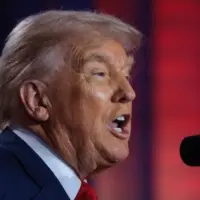
(WASHINGTON) — The U.S. economy expanded more than expected as President Donald Trump’s tariffs took hold over recent months, federal government data on Wednesday showed.
U.S. gross domestic product, or GDP, increased at a 3% annualized rate over three months ending in June. The figure marked a sharp acceleration from an annualized contraction of -0.5% over the first three months of 2025.
The reading amounted to sturdy economic growth, suggesting the economy has continued to avert a significant tariff-induced cooldown. A boost in consumer spending helped propel the economic surge, the U.S. Commerce Department said.
To some degree, however, Trump’s levies have blurred the GDP findings.
The government’s GDP formula subtracts imports in an effort to exclude foreign production from the calculation of total goods and services. Changes in the reading on this account reveal neither underlying economic weakness nor strength.
The measure of the GDP fell over the first three months of the year, largely due to a surge of imports as firms stockpiled inventory to avoid far-reaching tariffs. Conversely, a drop-off in imports over the second quarter may have inflated the second-quarter GDP figure.
The GDP growth “primarily reflected a decrease in imports, which are a subtraction in the calculation of GDP,” the U.S. Commerce Department said on Wednesday.
The U.S. economy so far has largely defied fears of a tariff-induced downturn.
The unemployment rate stands near a historically low level and job growth remains robust, though it has slowed from previous highs. Inflation has climbed over the last two months but it remains below where it stood when Trump took office.
In the months following Trump’s “Liberation Day” tariffs, in April, consumer sentiment declined to its lowest level in years, raising concern about a possible pullback in consumer spending, which accounts for about two-thirds of economic activity.
Consumer sentiment has ticked up for two consecutive months, however, as Trump has rolled back some of his steepest tariffs. Consumer spending has proven fairly resilient.
Wednesday’s fresh GDP data arrived hours before the Federal Reserve is set to announce its latest decision on interest rates.
An overwhelming 97% of investors believe interest rates will hold steady, according to the CME FedWatch Tool, a measure of market sentiment.
In theory, sturdy economic growth eases pressure on the Fed to lower interest rates, since consumers and businesses appear undeterred by high borrowing costs. If growth begins to slow, the Fed could seek to lower interest rates as a means of boosting economic performance.
The Fed has adopted a wait-and-see approach as it continues to observe the effects of Trump’s tariffs.
“Despite elevated uncertainty, the economy is in a solid position,” Fed Chair Jerome Powell said at a press conference in Washington, D.C., last month.
Copyright © 2025, ABC Audio. All rights reserved.














